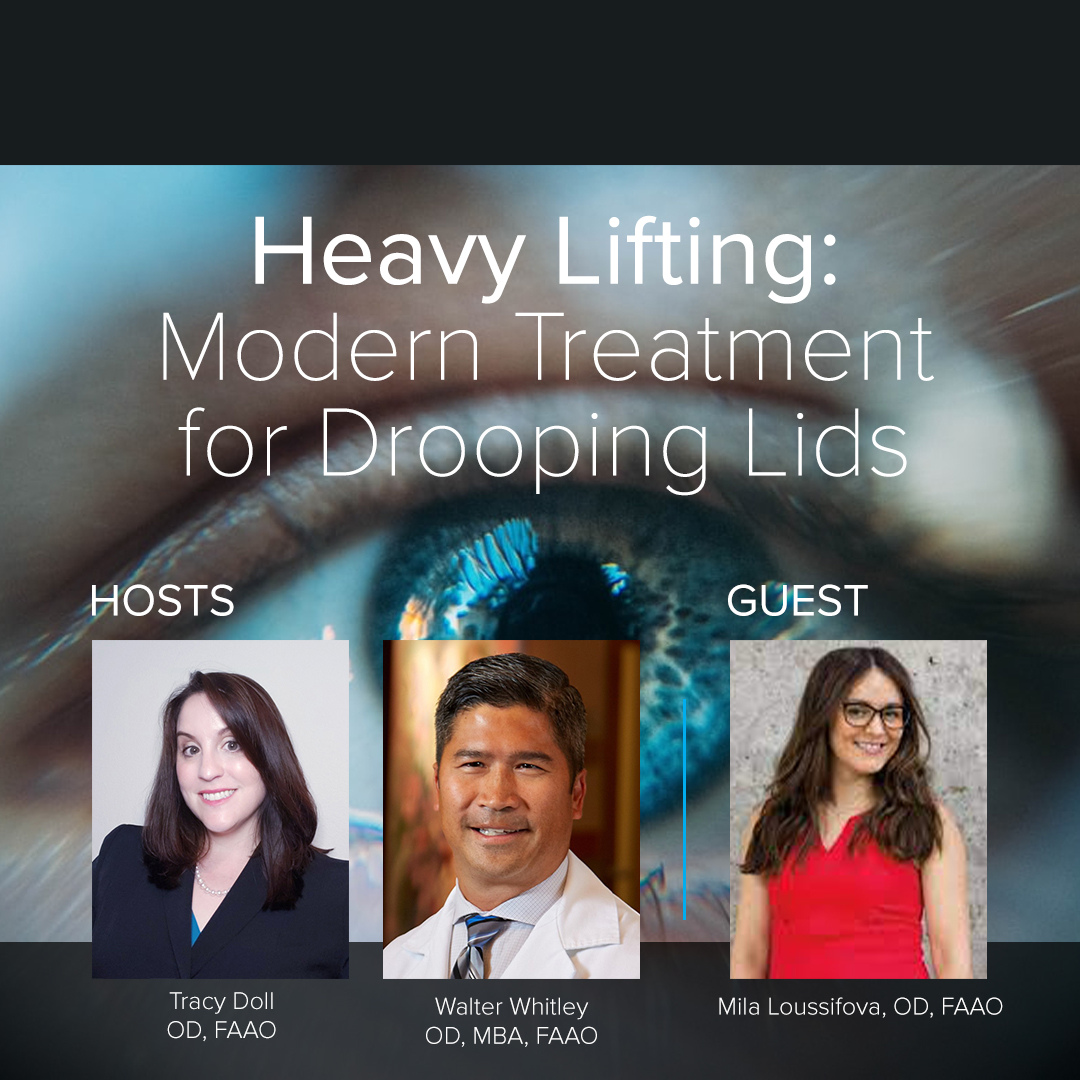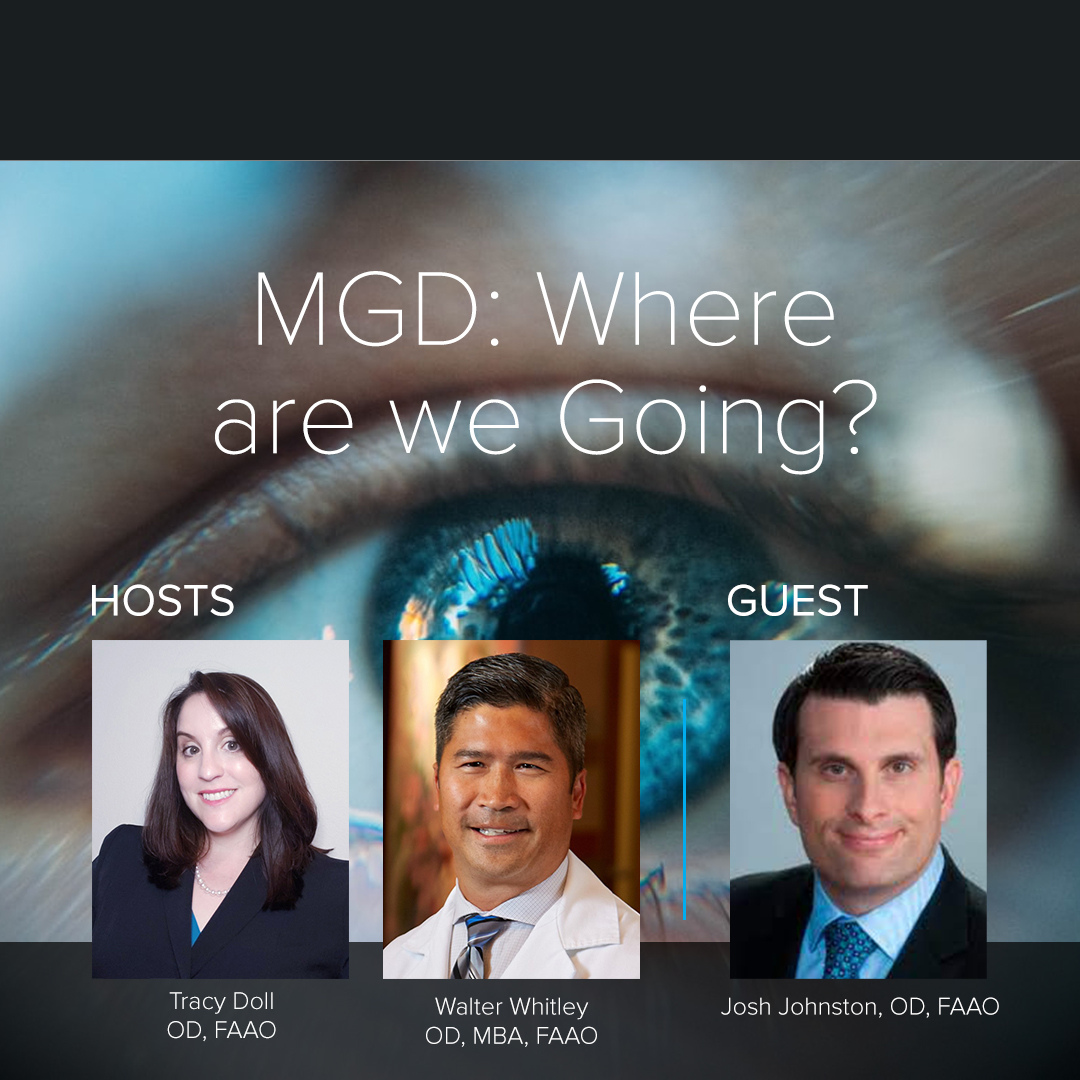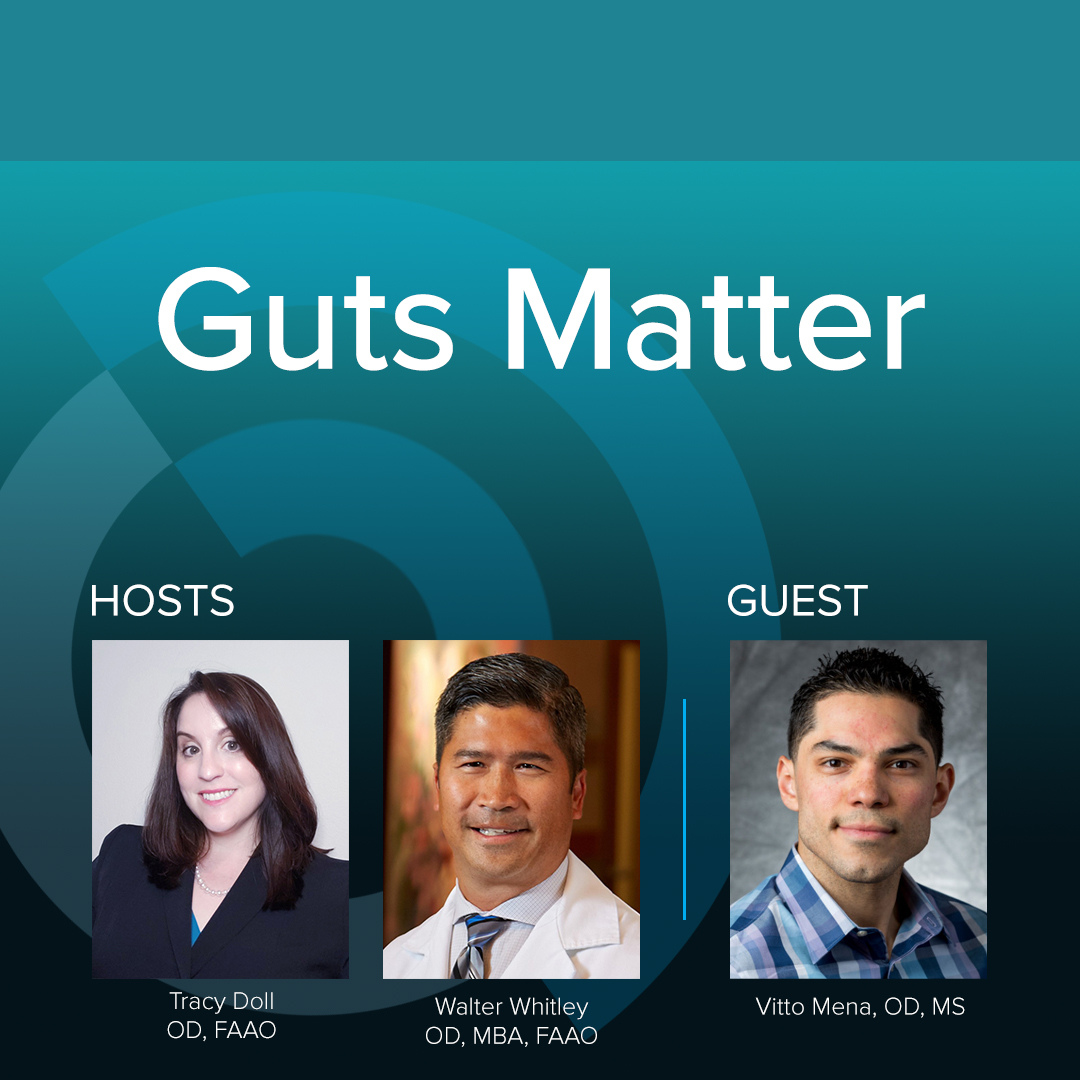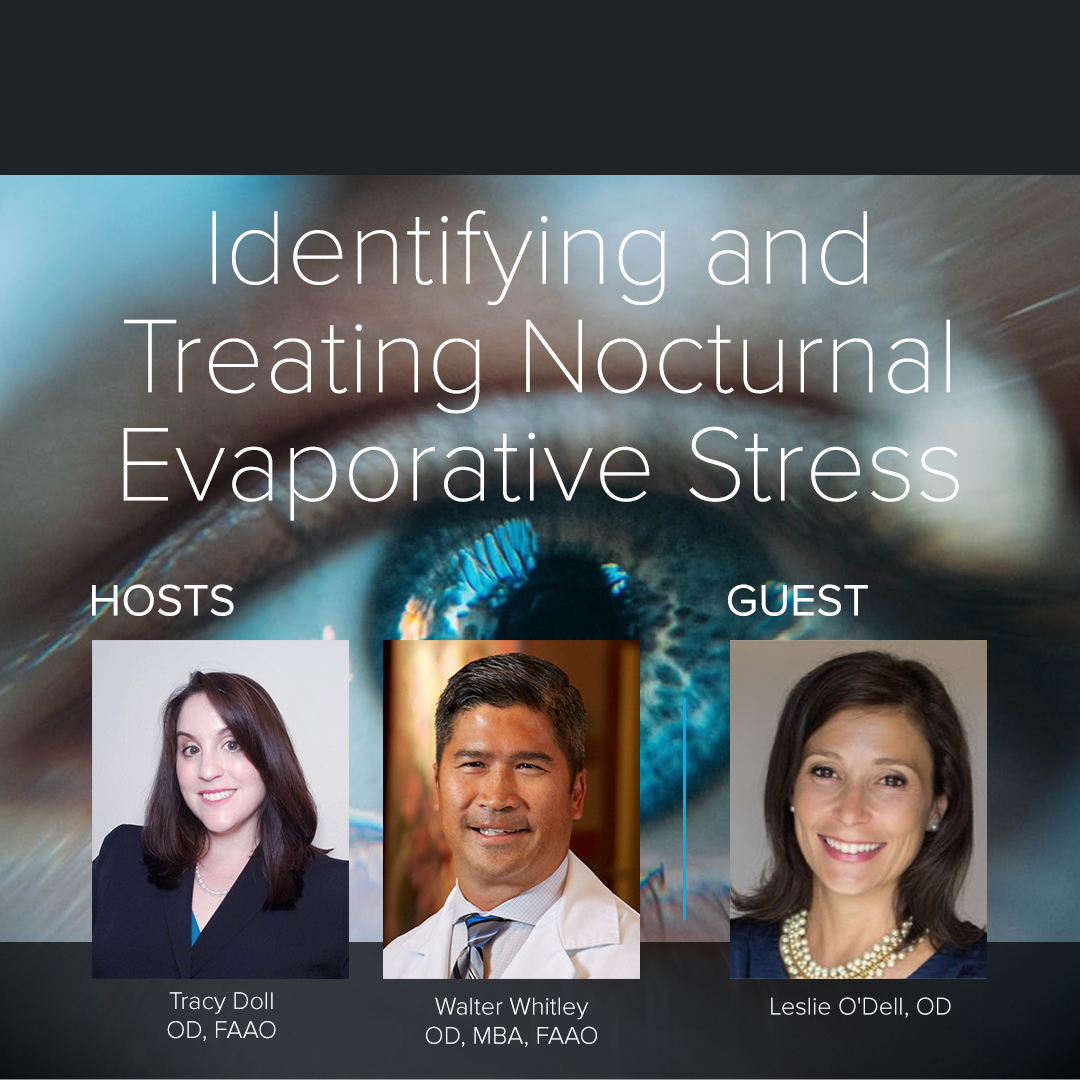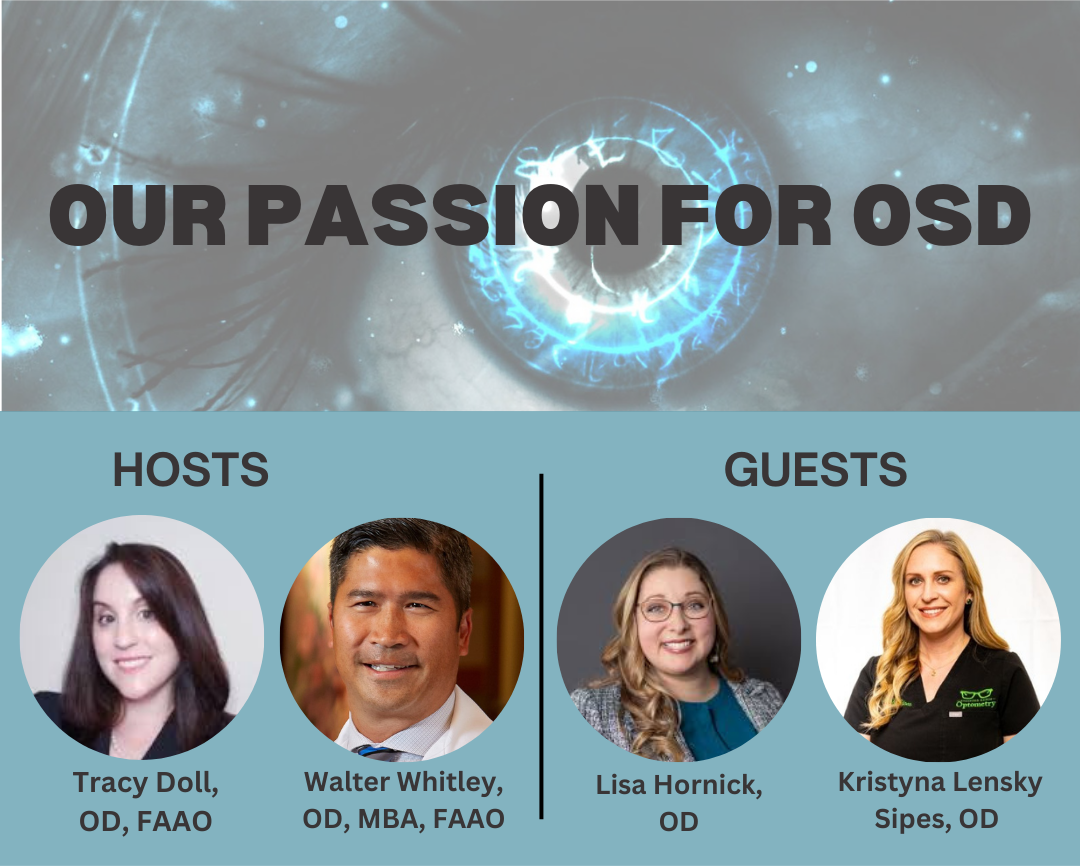Episode Transcript
[00:00:00] Speaker A: Welcome to the Dry Eye podcast series. Click on dry Eye, your insider path to the most exclusive dry eye topics. The series will raise awareness about the current and future state of ocular surface disease. The podcasts will focus on a variety of topics. Before we get to our next episode, here's a quick word from our sponsor. Doctor Perryman is going to share with us her pearls and insights of the role of the trigeminal nerve in ocular surface dryness treatments. Welcome, Laura.
[00:00:29] Speaker B: Thank you so much. This is awesome to be here.
[00:00:32] Speaker C: Yeah, we're excited to have you there, Laura. Appreciate you.
[00:00:36] Speaker A: I thank you so much for your time. We know you're busy ladies, so we appreciate you stopping on by.
[00:00:40] Speaker B: Anything for you guys.
[00:00:43] Speaker A: Now, you recently started your own specialty, dry eye practice. Can you tell us more about the practice and how you got it started?
[00:00:50] Speaker B: Sure. So we opened June 5, 2020 in the pandemic and 200 sqft with a single mission. And that is to address dry eye disease our way. And it's a combination of things I've learned across two and a half decades as a molecular immunobiologist, clinical medicine innovations, and clinical research. So it's the amalgam of all these different chapters in my life. And we have much fun providing world class dry eye care to our dry eye patients, giving them access to clinical research studies for early access to innovations. So it's been a lot of work, I won't lie, but a labor of love as well.
[00:01:40] Speaker C: So tell us about your team. Is it just you? Do you have several team members? You have a couple ods or fellows, I understand.
[00:01:47] Speaker B: Yes. The team is very interesting. So we have, I started off with a virtual office manager, somebody worked with. She was a technician when I worked at Redmond Eye clinic years ago and just loved her. Just a complete, incredible patient advocate, heart of gold, mouth of a sailor. I love her.
[00:02:09] Speaker A: She's amazing.
[00:02:11] Speaker B: And then Raquel is my licensed master esthetician, and she also helps with the clinical research studies. They both do. They both involve in clinical research studies. And it's so much fun because it becomes a career growth path for them as well.
And then we have two fellows, optometric fellows, and I love it so much because it's a way to elevate the next generation, right? And so these are two women who are going after their faao. And so I'm helping them with research projects, abstracts, presentations, publications, all that kind of stuff. Because I got to tell you, like, when I go to the AAOPT meeting, I love it when we come out of that first morning session and the carpets are littered with all the brand new faaos. It's just like, it's just, I just float down the hallway, I'm so giddy happy seeing the way these people are having their accomplishment recognized in such a public and celebratory way. I just love it. So I cannot wait to see their two names on the carpet, on the red carpet.
[00:03:24] Speaker C: Well, we're excited too. I mean, we're both part of the interior segment section for the academy. And yeah, anything they need help with or how we can be of service, please help them. Reach out to us anytime for any of that.
[00:03:35] Speaker B: Thank you. That's awesome. I super appreciate it. Takes a village, right? We're all in this together.
[00:03:41] Speaker C: Definitely. So with, with your practice, it's especially practice. So do you take insurance as a cash base? Because sometimes when we hear about these practices, some practices, not just in eye care, but in other specialties, that it may be a cash based elective type thing. So how was it at your practice?
[00:03:56] Speaker B: Right, so we went completely direct care and there was a very mindful reason for that. I tried over the years to mold myself into the six to ten minute encounter. And you just can't unravel the gnarled ball of yarn of dry eye disease in six to ten minutes. These patients deserve more. They have questions, they have anxiety, they have depression, they need to understand, they need to know you support them. They need to know that there's a lot we still don't know. But we're going to do our best. And we don't give up easily. That takes time. So we give our patients the gift of time. Now, that does create potential access issues. And that's another supporting reason for the clinical research pillar, is so that we can help create equity and parity by access to those early, early treatments in the form of clinical research.
[00:04:57] Speaker C: Yeah, you know, be involved with research studies in the past. You get some patients, they love to do research. Like when's the next study?
You gotta wash out this one before we can do the next one. But either way, so, you know, you mentioned your background, so how's your passion for immunology and dry, how they complemented each other?
[00:05:17] Speaker B: Well, I think they are born from the same source. And that's. I'm definitely a clinician scientist. I'm a nerd at heart. I love understanding how things work and that drive of understanding why things work on a cellular level, on a mechanistic level, on a cytokine level, that insatiable curiosity that was planted in my brain before medical school has never gone away. I still want to know how things work and how they integrate. And if you think about the awesome things in our toolkit, we have a lot of interfacing with some of that crazy, elegant, complex immunopathophysiology we call dry eye disease.
[00:06:05] Speaker A: When you know why something or how something should work, you can figure out why it doesn't and where to specifically target it. That's what I love so much about your passion for immunology and dry eye and love having you here. I also want to hear about what you're currently doing with neurostimulation. Like, where do you feel that that's fitting in right now?
[00:06:25] Speaker B: Oh, I love that topic of neural stimulation. So we had the good fortune of being a phase three FDA study site for iter by olympic ophthalmics. They're a suburb here in Seattle, Nysequal, Washington, and we got to be a study site for that multicentered study. And it was awesome. Like to have the luxury of time to really closely observe what's happening with your dry disease patient with respect to an intervention that's powerful and that has enhanced my understanding of the entire lacrimal functional unit, the entire ocular surface disease milieu in such an enriching way. We published on it in November of 2021. I'll get the reference for you. Our data. And neural stimulation is a real thing. You can see the tiraminiscus height going under neural stimulation. You can see Meibum coming out of the terminal ductuals during neural stimulation under high magnification video slit lamp. It's incredible. We also know that you get degranulation or mucin release from goblet cells under neural stimulation. So this concept that the key players in a healthy pre corneal tear film, meibum, mucin and aqueous are under the neurobiological control of the central nervous system is new, relatively speaking, and understanding of dry eye disease. But it's also very real and very exciting as well.
There's other neural stimulation modalities as we've good news. We've got Terriya now, Vereniclin. That is a really interesting intervention as well.
I love doing test doses in the chair. Obviously, you can't reuse the bottle. You gotta have a fresh one for every fresh patient because it goes up your nose. It's a nose spray.
It's amazing to me to watch the patients do it. And you can see the little tear meniscus height going up. They're like oh, wow. That really works. So it's very, very fun to have these different neural stimulation modalities. And I use neural stimulation not only as a therapeutic, but I'll even use it as a diagnostic to see if the electrical wiring, if you will, is even intact or is the system completely burned out. So I'll use it diagnostically, therapeutically. I think there's a short term, medium term, and long term benefit of neural stimulation. It's not just there's much more going on with neural stimulation.
[00:09:12] Speaker C: So you just mentioned you use it diagnostically. Can you speak to that to make it clear for everybody exactly how you're using that? Is it like a dose in office? Is it for a week, or can you tell us more?
[00:09:25] Speaker B: Yeah. So, in the lane, if I have a patient that's got severe dry eye and I need to find out if the system's even intact, then I will use neural stimulation. And if the tumor scores don't budge at all, I know that the system's pretty broken. Right. And that's once you get that complete neural short circuiting or end organ failure that is the lacrimal gland.
That's prognostically important for the patient to understand. You really gotta think big about your modalities. You're definitely looking at scleral lenses, other modalities such as this, but it's.
It's also very telling. So if you have a patient that has a pretty normal osmolarity and a high MMP nine load and a bunch of staining, you got to ask the question, when's the last time you used your tears? Right? Oh, an hour before I got here.
[00:10:21] Speaker A: Ah.
[00:10:21] Speaker B: Gotcha. Right.
I find that all these things are very, very helpful.
Yeah. So it's another arrow in the quiver, and I find it to be really helpful in a couple of other clinical situations.
If there's a history of migraine headache disorder, if there's a history of depression, these are also neural based problems. And dry eye and migraine headaches share some pathology in the trigeminal nerve. Well, with neural stimulation, you're able to bypass the corneal nerves that might be smoked out from chronic hyperosmolarity and create that neural flow through the brain stem and the command fibers, if you will. Hey, lacrimal gland, pick up the place. Getting a little salty in here.
My bone, it's like, come on, there's wind out there. I need you to protect all this. And, of course, the mucin cells as well.
I find that the migraine sufferers, the depressed patients, really kind of need the neural stimulation, and it becomes a particularly beneficial adjunct for them. Yours truly suffers from ADHD. I didn't used to. It's a gift of menopause.
[00:11:43] Speaker A: Yay. The gift that keeps on giving.
[00:11:45] Speaker B: Oh, yeah, yeah. There's lots, lots of that.
But it actually helps me focus just a little bit as well. It improves my focus. I wonder if this is what a smoker feels like after they smoke a cigarette. I don't know. I'm not sure, but I feel calmer, and I'm definitely more focused. And the entire office appreciates that, because when I'm around, it's like hurting a cat. Like, where is she going now?
[00:12:07] Speaker A: So when you're doing this kind of, like, diagnostic check, are you using more of the mechanical or the pharmacological stimulation or does it matter? Just whatever you can grab first.
[00:12:16] Speaker B: Well, it does matter. It's d. All the above. What do I have handy? What's ready to rock? And is there going to be barriers to acquisition for the patient? That is coverage issues. Right. So that enters into my calculus as well. If I'm looking at a patient who I'm pretty darn sure their insurance isn't going to cover it yet, then I'll reach for the mechanical. Some patients prefer the mechanical. The.
Some patients prefer the nasal. And it's just wonderful to have another option.
The very keen observer patient will tell you that their vision is better after neural stimulation. And so this can be something that we can potentially try on our 2020 unhappy host. Cataract patients. There's a term, gosh, it was just recently pegged and by Tal Reviv and Daryl White. It's like the.
What do they call it? There's an acronym for it, but basically it's dysphoria after cataract surgery. Like, there's some kind of, like, discontent malcontent with your visual performance after cataract surgery. And I think this is a great thing for that, including pupil modulation. But that's probably another podcast episode. Yeah, probably.
[00:13:32] Speaker C: Don't worry. Hey, you mentioned. You mentioned for the diagnostic, increased schirmers, and you also mentioned the. The other layers of the tears. And I think one of the things is we only see part of the data. I mean, one of the things I reference in a lot of my lectures is that paper that your poster you presented at ASCRs. We were able to show the improvement within the meibomian gland secretion and other factors as well.
So how do we know? We have your data. We have more studies coming out, but it's a huge topic here.
[00:14:05] Speaker B: Right. So again, I love understanding how things work. If you go to James Jester's work from about five, six years ago, published in the Oculosurface journal. He's brilliant. PhD researcher at UC Irvine. He was able to demonstrate that the meibomian glands are wrapped with sympathetic and parasympathetic fibers.
And the diagrams reminded me of a tree wrap on a Christmas tree. Of the lights.
[00:14:35] Speaker A: Right?
[00:14:35] Speaker B: It's just like it's all over. It's all over the tree. There's lights everywhere in there. And so when you do neural stimulation, you're actually getting some of that as well. And that sympathetic parasympathetic tone helps influence the meibomian gland stem cell activity.
So I think that explains why we saw this really impressive improvement in meibum secretion scores over the course of the mechanical neural stimulation study.
[00:15:07] Speaker A: How many times a day are you recommending that your patients do neurostimulation?
[00:15:14] Speaker B: I'll answer that in just a second. I forgot to tell you one more thing.
When we saw the meibom actually coming out during neural stimulation, there's a little tiny muscle called the muscle of rheolon, which surrounds the meibomian glands. And that probably gets activated and squeezed just a little bit as well, maybe. So it's sort of like giving a woman pitocin during childbirth. It just forces that stuff out of there anyway. Yeah. How many times a day?
So it depends on the severity of the disease and what I'm treating. So if it's a neurotrophic, like a stage one neurotrophic keratitis, I'll do it more like four times a day. Trying to stimulate those corneal nerves to send that, you know, substance p epithelium. Everything's fine. It's groovy, don't worry. Like putting that happy music out there on that corneal surface.
So more like four times a day, very severe disease, more like four times a day. And then usually we can taper back at the end of 30 days to more of a twice a day. Maintenance and then duration completely depends on the clinical picture as well. Some patients, their basal tear production improves to the point where they kind of don't need it, so they stopped using it. But when they start, when that starts to wane, maybe because they're not being diligent with their immunomodulator therapy. Cyclosporine, lifidograss, pulsedo steroids, whatever this is, their omegas, fatty acids, all those things.
When that baseline tumor, meniscus height starts to wane just a little bit. Then they go back to the external neural stimulation device, and they get that same robust Schirmer's tear production. What was so interesting is, during the study from the mechanical extra nasal stimulation iteR, Olympic ophthalmics, is there was a robust improvement in stimulated tear on day one, and the amount of tear release at two weeks and four weeks wasn't quite as robust. And the patient misinterpreted. That is, it's no longer working. But what actually happens is your basal tear secretion increases, which explains why the tear breakup time was so much better, why the corneal keratopathy improved. It's, um, that that sensation is not where the only magic is. There's so much more going on with neural stimulation.
[00:17:44] Speaker C: Yeah, it's such an exciting topic right now. And, you know, and to be clear, it's been around for a while. I mean, we had true tier and true tier work.
[00:17:52] Speaker B: I still have mine.
I hoard, I hoard the activators.
[00:18:00] Speaker C: I mean, we have patients that say, hey, this thing has truly changed my life. And we want to be clear that it does work. It was the business model is essentially why truth here isn't available. Do you have any comments on that?
[00:18:11] Speaker B: I think it made me sad that it wasn't sustainable because it is a great technology, and the more tools we have, the better. Because let's be real, not every patient is going to accept every type of intervention. So it's nice to have options, access, all those sorts of things. I think we're learning as we go along what the market will bear, what patients will bear. And I think a lot of it has to do with our colleagues understanding and how they present and explain it to the patient, how they show the value of what they are recommending and prescribing.
[00:18:46] Speaker C: So tell me about sneezing. What are you telling the patients?
[00:18:50] Speaker B: I tell them that's normal. It gets better in a few days.
[00:18:55] Speaker C: I do as well.
[00:18:56] Speaker B: Yep.
[00:18:56] Speaker A: That's the biggest hurdle I find with the patients that I'm trying to prescribe, too, is that they just don't like the sneezing the first couple of days and they want to quit. I'm like, nope, keep going through it.
[00:19:04] Speaker B: Keep going, keep going. Give it, give it the full seven day try. Let's go.
[00:19:08] Speaker A: I'm a non sneezer, so I don't have that experience. Oh, you don't sneeze?
[00:19:11] Speaker B: You're lucky. I sneeze like crazy the first couple days. Woo. That was impressive.
[00:19:15] Speaker A: I'm one of the weird ones. That doesn't.
[00:19:17] Speaker B: Nice. I kind of like the sensation, honestly. I like that black pepper tingle, like, because I like to cook soup and like, you put too much pepper in there and you go over too soon and like, whoa. Goes up your nose. They're like, whoa. Yeah, that's pepper.
[00:19:32] Speaker A: I like wasabi for the same reason.
[00:19:34] Speaker B: I love wasabi for that same reason. I'm like, oh, those tears that feel so good.
[00:19:39] Speaker C: You know, one of the questions we often get is, you know, where do you use something like tear via if we're going to go back to the. For the drug itself, you know, are you using drug naive patients? Is this chronic? Or maybe what's the, what's the one thing that you're noticing the most whenever you're using the tear via?
[00:19:56] Speaker B: I think the thing I'm noticing the most is the improvement in the basal tear secretion over continued use. That's the thing I'm noticing the most. There seems to be. I also see improvements in staining over the course of time.
There's. Yeah, so I think we're all learning together in the post market experience, but I had a little bit of an early start because of our involvement with the mechanical extra nasal, and I think they work pretty similarly. Actually, it's the same pathway we're tapping into.
[00:20:25] Speaker C: Yeah. Tracy, what are you noticing for me? I'm noticing them using less tears, using the artificial tears as often.
[00:20:33] Speaker A: The contact lens patients are really big fans because there's nothing that they can, especially with the scleros. When you're trying to get the scleros to keep wetting effectively, they're, they're probably the biggest expanse.
[00:20:44] Speaker B: I love that. That's a really smart use of it in a contact lens patient. You betcha.
[00:20:50] Speaker A: Okay.
Do you have any one take home pearl for our listeners, when it comes to ocular surface disease, I know it's hard to get you to boil down one fact because you're just a fount of knowledge. One take home pearl for our listeners.
[00:21:04] Speaker B: One take home pearl is stay curious, keep learning, because this is a rapidly expanding field. It's thrilling, it's exciting. Don't let it overwhelm you. Just stay curious with it, stay with it, keep studying, keep learning, keep coming to the meetings, keep listening to awesome podcasts like this. But just lean in, don't be afraid of it. The future looks bright.
[00:21:28] Speaker A: Thank you. Any other questions from you? Waltz?
[00:21:31] Speaker C: No. Hey, we just appreciate you being here, there, Laura, thank you so much for your time and expertise and sharing with our listeners the role of the trigeminal nerve and ocular surface disease treatment and diagnosis as well.

